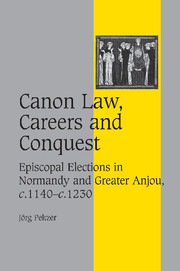Book contents
- Frontmatter
- Contents
- List of maps
- List of tables
- Preface
- Editorial note
- List of abbreviations
- 1 INTRODUCTION
- 2 ELECTORAL THEORY
- 3 ELECTORAL PRACTICE: NORMANDY
- 4 ELECTORAL PRACTICE: GREATER ANJOU
- 5 THE EPISCOPACY IN NORMANDY AND GREATER ANJOU
- 6 THE IMPACT OF THE CAPETIAN CONQUEST OF 1204/6
- 7 CONCLUSION
- APPENDICES
- I The episcopacy of Normandy and Greater Anjou, c. 1140–c. 1230
- II The date of Causa super controversia
- Bibliography
- Index
- Cambridge Studies in Medieval Life and Thought Fourth Series
II - The date of Causa super controversia
Published online by Cambridge University Press: 09 August 2009
- Frontmatter
- Contents
- List of maps
- List of tables
- Preface
- Editorial note
- List of abbreviations
- 1 INTRODUCTION
- 2 ELECTORAL THEORY
- 3 ELECTORAL PRACTICE: NORMANDY
- 4 ELECTORAL PRACTICE: GREATER ANJOU
- 5 THE EPISCOPACY IN NORMANDY AND GREATER ANJOU
- 6 THE IMPACT OF THE CAPETIAN CONQUEST OF 1204/6
- 7 CONCLUSION
- APPENDICES
- I The episcopacy of Normandy and Greater Anjou, c. 1140–c. 1230
- II The date of Causa super controversia
- Bibliography
- Index
- Cambridge Studies in Medieval Life and Thought Fourth Series
Summary
Samuel Loewenfeld copied Causa super controversia from volume cclxxix of the Collection Baluze, Bibliothèque Nationale de France, Paris. Another copy of this letter can be found in a seventeenth-century history of the bishops of Angers attributed to Guy Arthaud, archdeacon of Angers, which is preserved at the Bibliothèque Municipale, Angers. This second copy was taken from the original found at Angers in November 1664. Unfortunately the original disappeared some time thereafter. Whether both copies were transcribed independently from each other or whether the Angers copy or its author served as source for the Baluze transcript cannot be established with certainty. According to both copies the bull was issued on the VII kalendae maii, thus 25 April 1156. However, there are reasons to believe that the letter dated from the VII kalendae martii, thus 23 February.
The abbot of St Albans, Roger, and his colleagues left for the papal court at the beginning of October 1155 to undertake ‘ardua negotia regalia’ for Henry II. They arrived at Benevento, presumably around Christmas, and their business had been dealt with by the end of February 1156. A short time later, the king's envoys must have left Benevento. According to the chronicle of Vézelay, the abbot of St Albans, the bishop of Le Mans and the bishop of Evreux spent Easter, that is 15 April 1156, at the monastery.
- Type
- Chapter
- Information
- Canon Law, Careers and ConquestEpiscopal Elections in Normandy and Greater Anjou, c.1140–c.1230, pp. 264Publisher: Cambridge University PressPrint publication year: 2007

